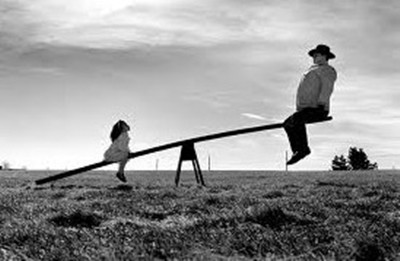Remember seesaws? Those things were great.
還記得蹺蹺板嗎?它可是偉大的發明,
But there wasoften a problem.
但仍然存在一個問題。
Suppose there's a big kid on one side and a smaller kid on theother side.
假設蹺蹺板的一邊坐一個大點的孩子,而另一邊坐一個 小點的孩子。
The seesaw just stays in one position:
蹺蹺板就只停留在一邊:
big kid on theground, smaller kid up in the air. No fun.
大孩子那邊,小孩子則懸在空中。這樣就失去了蹺蹺板的樂趣。

After a few differenttries, you probably realized that moving the big kid in towardthe center made it possible to rock a little.
幾次嘗試后,你也許會發現讓大孩子往中間坐久可以搖動一點。
Move the big kid evenmore and you can achieve balance.Now the seesaw works.
再讓大孩子讓中間挪動直至平衡后蹺蹺板就可以搖動了。
What's going on here?
這到底是怎么回事?
The answer is in the “center of mass.”
答案就是“質心”。
The center of mass is a pointsomewhere along the plank that holds the two kids where their average weight falls.
質心是蹺蹺板上支撐兩個孩子平均重量的一個點。
If you can getthe center of mass to be over the pivot point, the seesaw will be balanced.
如果找到了是新的支點,蹺蹺板就平衡了。
There's a simple way to figure out where the center of mass is.
有一個簡單的方法找出質心。
If the big kid is two times as heavyas the little kid, then their mutual center of mass will be two times closer to the big kid than to thelittle kid.
如果大孩子的重量是小孩子的2倍,那么質心的位置離大孩子的距離就比離小孩子距離近2倍。
Three times heavier and the center of mass will be three times closer. And so on.
重三倍,質心的位置就進三倍,以此類推。
So the reason the heavy kid sits on the ground while the light kid is up in the air is that theirmutual center of mass is on the heavy kid's side of the pivot.
因此,重的小孩坐在地上而輕的小孩懸在空中的原因是,他們共同的質心在重的孩子這邊。
To make the seesaw work, theheavy kid must push that center of mass forward until it just touches the pivot.
要想讓蹺蹺板搖動,重的孩子就得往中間挪直到質心移到中心。
Then theiraverage weight pushes right on the middle, letting the ends rock up and down.
然后當他們的平均質量正好在中間,這樣兩頭就可以上下搖動了。











